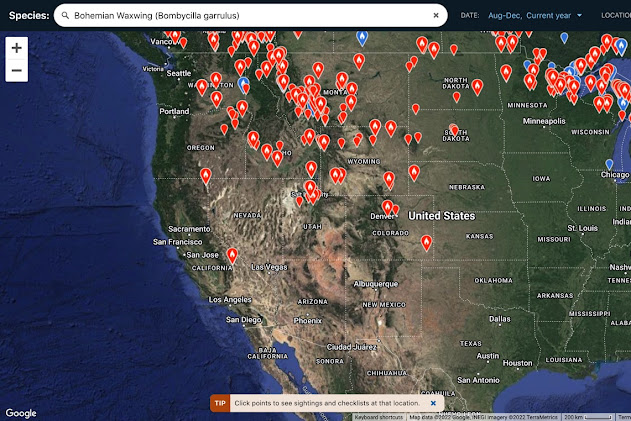Hey everyone,
After a hiatus long in posting for the past six years I have hopped back on the blog with some exciting news! As many of you have probably noticed by now, the winter of 2022-2023 is turning out to be an exceptional year for irruptive species. Most notably, for Arizona, is the possibility of getting Bohemian Waxwings as they've been rapidly working their way south with recent records from Pueblo (just reported today on 12/9/22) and Baca Counties in Colorado, a single individual in Lone Pine, California, and several flocks around Salt Lake City, Utah.
2022 Aug-Dec reports of Bohemian Waxwing on eBird -- Courtesy of eBird
Given the lack of much birding coverage in extreme northern including the Arizona Strip, there could very well be Bohemian Waxwings in the state as your read this! If you're starting to feel a great urge to get out and look for this species, you now know the feeling I've had for the past week as I've tracked their irruption south. So to no further avail, here's some info on what to look for in finding and identifying this boreal species, how to look, and where to put yourself in order to maximize your odds at coming across one.
Identification:
Bohemian Waxwing is in the same genus as its more commonly-known sister species, the Cedar Waxwing. There's only one of species of waxwing in the world, Japanese Waxwing, but as the name implies that species occurs in East Asia, so we will only compare Bohemian and Cedar Waxwings. Luckily, the identification between these two species is easy and straightforward. Bohemian Waxwing is larger in size than Cedar, so the size will often catch one's eye first. Going into detail in plumage, the most obvious identification features one will observe are the chestnut rust undertail coverts, a broad white horizontal line above the primaries, and a white or yellow vertical line going down the primaries. Other less-obvious field-marks include a more contrasting black throat, a pinkish-red hue to the front of the face, and a colder gray-toned body and belly (as where Cedar has a yellow belly).
Vocalizations also differ between the two species with Bohemian often-times giving calls that are lower pitched, more drawn-out staccato notes in the trill making it sound slower, and a downslur to the entire series.
To see these differences click (HERE)
How To Look:
Waxwings are social birds often times mixing in flocks containing both species, robins, starlings, and bluebirds, so finding one (or a whole flock) is relatively easy if you get on a flock and scan through each individual bird. Remember, large size, rusty undertail coverts, and pale lines around the wing tips! These flocks travel around together in search of fruiting trees, which is a big clue on finding them. Waxwings will feed on about any type of edible fruit but they especially like crabapples, cherries, junipers and russian olive. The former two trees are often times planted in neighborhoods in rather low numbers so staking out a tree in that setting will likely be more productive than to set yourself in a mid-elevation filled with hundreds to thousands of juniper trees where they could be anywhere. Keeping an eye out for feeding flocks of waxwings, bluebirds, and robins with greatly increase your chances of finding a Bohemian!
Where To Look:
Depending on how much longer the irruption lasts and how much further south these birds move will determine where in the state they show up. Historically, there are records from as far south as Portal (Cochise County, AZ) and Seven Springs (Maricopa County, AZ) and given how early these birds are occurring so far south (normally the peak of the irruption doesn't happen till January and February in the Southwest), this could very well be one of those years where they show up in Central or Southern Arizona. However, I'm going to place my bets where I feel most confident these birds are going to first be found, and that's in far northern Arizona (Flagstaff and north). Thus, I will focus on areas to search within this region. The NAU campus is a location with fruiting trees and has hosted a large flock in the past but my good friend John Wilson in currently taking classes there so he will surely find them if they are around. Other spots that come to mind include towns and cities such as Chinle, Many Farms, Tsaile, Kayenta, Ganado, Tuba City, Page, Fredonia, Colorado City, and Littlefield. Along the Lower Colorado River Valley Bohemian Waxwings have also been found feeding on the fruit of the abundant palms plants all over the residential areas.
With all of that information, I hope you feel a little better on the search! If you have any questions or would like to discuss this irruption with me feel free to comment or email me at strandcaleb@yahoo.com

Especially check Russian olives which are about the only fruit-bearing trees across all of northeastern AZ in winter. In the past they have been seen into April in this region.
ReplyDelete